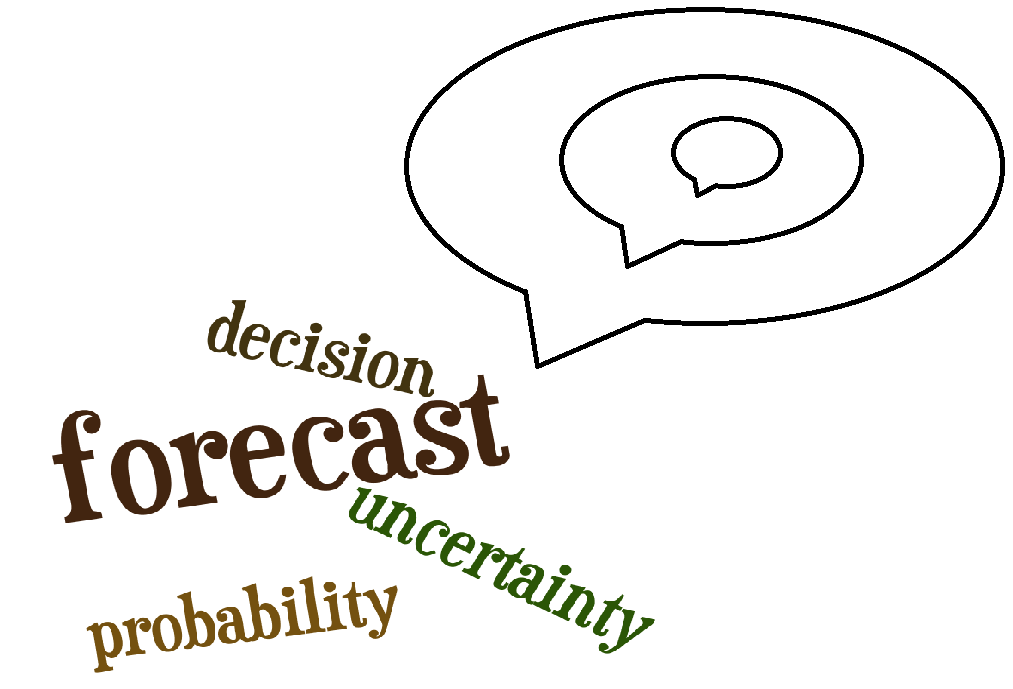HEPEX-SIP Topic: Communication and Decision Making (1/4)
Contributed by Florian Pappenberger, Liz Stephens, Jutta Thielen, Schalk-Jan van Andel and Maria-Helena Ramos
What is communication and decision making?
 In both the hydrological research and operational communities, forecasting systems are moving towards the use of ensemble prediction systems (EPS) rather than single deterministic forecasts (Cloke and Pappenberger, 2009), with many different hydrological and flood forecasting centres now using EPS operationally.
In both the hydrological research and operational communities, forecasting systems are moving towards the use of ensemble prediction systems (EPS) rather than single deterministic forecasts (Cloke and Pappenberger, 2009), with many different hydrological and flood forecasting centres now using EPS operationally.
Ensemble prediction systems use multiple realisations of the forecast model to provide a probabilistic rather than categorical forecast. Ultimately, their aims are:
- to form a key part of disaster ‘preparedness’ strategies by providing early warnings of imminent flood events (e.g., de Roo et al., 2003, Patrick, 2002; Werner, 2005) or forecast drought awareness, and reducing the impact of severe events through providing adequate preparation time to water managers, the civil protection authorities and the public (Penning-Rowsell et al., 2000);
- to provide probabilistic information of added value to the optimization of water resources for water managers and the maximization of economic returns for water users.
Much of the research in the recent years has focused on improving the accuracy and skill of these forecasts. However, it has been argued that these developments would be irrelevant if not communicated effectively to, and understood by, decision-makers (Demeritt et al., 2010). Also, it is now increasingly recognised that the communication of the uncertainty associated with scientific forecasts is as important for risk management as increasing their accuracy and timeliness (NRC, 2006, EA, 2012).
Accordingly, clear definitions and guidelines with a common understanding between different communities of for example meteorologists, hydrologists and decision makers are needed, as well as new ways of translating uncertain forecast information into clear visualisations and concise communications to decision makers and the general public.
Here, communication and decision making is defined in the widest sense, as it includes inter-expert communication, communication to the public, as well as communication to feed decision making on the level of private companies and public institutions. Additionally, it also includes institutional cultures and legal frameworks for communication and use of probabilistic forecasts. Visualisation of ensemble forecasts is thus seen here as an integral part of communication.
Experience in other domains suggests that:
- the design and framing of uncertainty information is important in shaping how it is understood and acted upon by recipients (NRC, 1989, EA, 2012).
- A successful communication of probabilistic forecasts is tailored to the characteristics of the individual user groups and their specific requirements (Stephens et al., 2012, EA, 2012).
- Therefore, particular attention needs to be paid also to the various end-users of hydrological forecasting systems.
What do you think?
________________
Part 2: Communication and decision making within HEPEX and related activities (https://hepex.org.au/hepex-sip-topic-communication-and-decision-making-24)
Part 3: Literature review on communication and decision making (https://hepex.org.au/hepex-sip-topic-communication-and-decision-making-34)
Part 4: Challenges and research needs (https://hepex.org.au/hepex-sip-topic-communication-and-decision-making-44)
0 comments